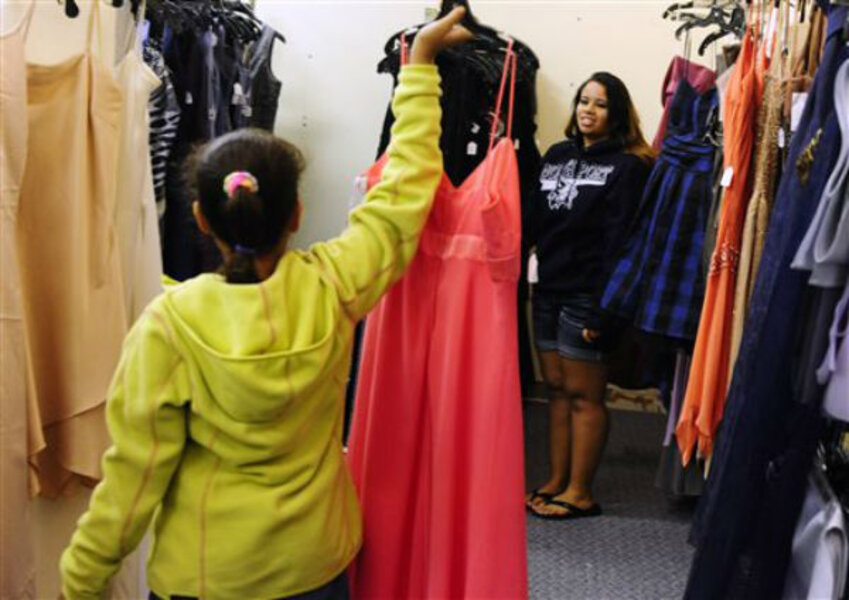Dress codes set tone for Florida school dances
Loading...
| Clearwater, Fla.
Students at Dunedin High School knew what to expect when they walked into the school gymnasium this month for the homecoming dance: "Nothing too short, nothing too tight, keep everything covered and no sexual acts or (explicit) dancing," said sophomore Alexander Booker.
School administrators even made students sign a contract stating they understood the requirements before they were allowed to attend the much-anticipated dance. But, according to junior Kiyana Scott, the rules made the night a better experience.
"There was a huge difference; the dance my freshman year was way worse," Scott said. "Most kids were OK with the dress code, and everybody acted real respectful instead of just wanting to look good or show off."
Many Pinellas County high school officials attribute the change in attitude to stricter dress codes that have made short shorts, mini skirts, and in some cases even cheerleading uniforms worn during school hours a thing of the past. This school year many of the county's 17 high schools, including Dunedin High, enacted new dress codes regulating everything from logos on clothing to the fabric from which apparel is made. Homecoming, prom and other school dances are no exception.
High schools sent home letters and emails, made automated telephone calls, issued morning announcements in classrooms, and had students sign contracts before the dances to ensure they complied with the school's standards. At many dances that meant dresses could not be shorter than 3 inches above the knee, and pants had to fit at the waist or else a school official would hold it up with zip ties.
Though the school district's dress code states that students are expected to wear formal or semi-formal attire to school dances, it's up to school administrators to determine whether outfits are appropriate, said school district spokeswoman Melanie Marquez Parra.
In Hillsborough County, high school principals did not send formal letters about wearing appropriate clothing to homecoming dances this year, but they did make informal announcements to students, said school district spokesman Stephen Hegarty.
For instance, students are told not to wear jeans or sneakers to dances, he said.
Unlike years past, Pinellas school board member Rene Flowers said, she has not heard of any student being told to leave the school's dance for dressing inappropriately.
Many principals enforce a stricter dress code throughout the year to encourage better behavior, and the lack of disciplinary issues at this year's homecoming dances appears to support that practice, Flowers said. Girls have been told to dress for the dances like they would for a fancy office party, portraying a professional image without "overly cleavaged, bare-backed" dresses, she said.
"I do think it changes the way you think about your education because you're dressing like you're going to work, and it helps you enjoy moments like dances because you're not worried about pulling your tube top up every five minutes, or holding your pants up with one hand while you walk," Flowers said.
Creating a fancier atmosphere for the dances also helped students dress and act "classy, not trashy," said Bob Vicari, principal of Lakewood High School in St. Petersburg. The school's homecoming dance was held at the Gulfport Casino instead of the school gym as it has been in years past.
Students were willing to pay $30 for tickets to have a bigger event, and the combination of the special venue and months of dress code enforcement resulted in "kids dressed to the nines," Vicari said.
"When they have to pay for the tickets they don't want to do anything to be sent home, and with the new dress code this year they know we mean it," Vicari said. "I didn't see anything real provocative."
Though Largo High did not switch to a modified dress code this school year, students were told they were expected to make efforts to "look better and act better" than previous years, said Largo High School Principal Brad Finkbiner.
When it came to the homecoming dance, school officials left it up to student government members to create this year's dress code, which was "very formal and respectable," Finkbiner said. No students were sent home from the dance, held in the school's gym, for being inappropriately dressed, and the exercise proved "the higher we set standards for students, the higher they'll rise to meet them," he said.
Jade Copeland, a sophomore at Northeast High School in St. Petersburg, said the fact her school did not change its dress code this year makes students even more conscious of what they wear to school and dances. There's always a risk that if they don't follow the rules, students might get a uniform, too, she said.
"They let people express themselves through the way they dress as long as they don't have their chest out, but they warned us to follow the rules," Copeland said. "At the dance everyone was covered up."





